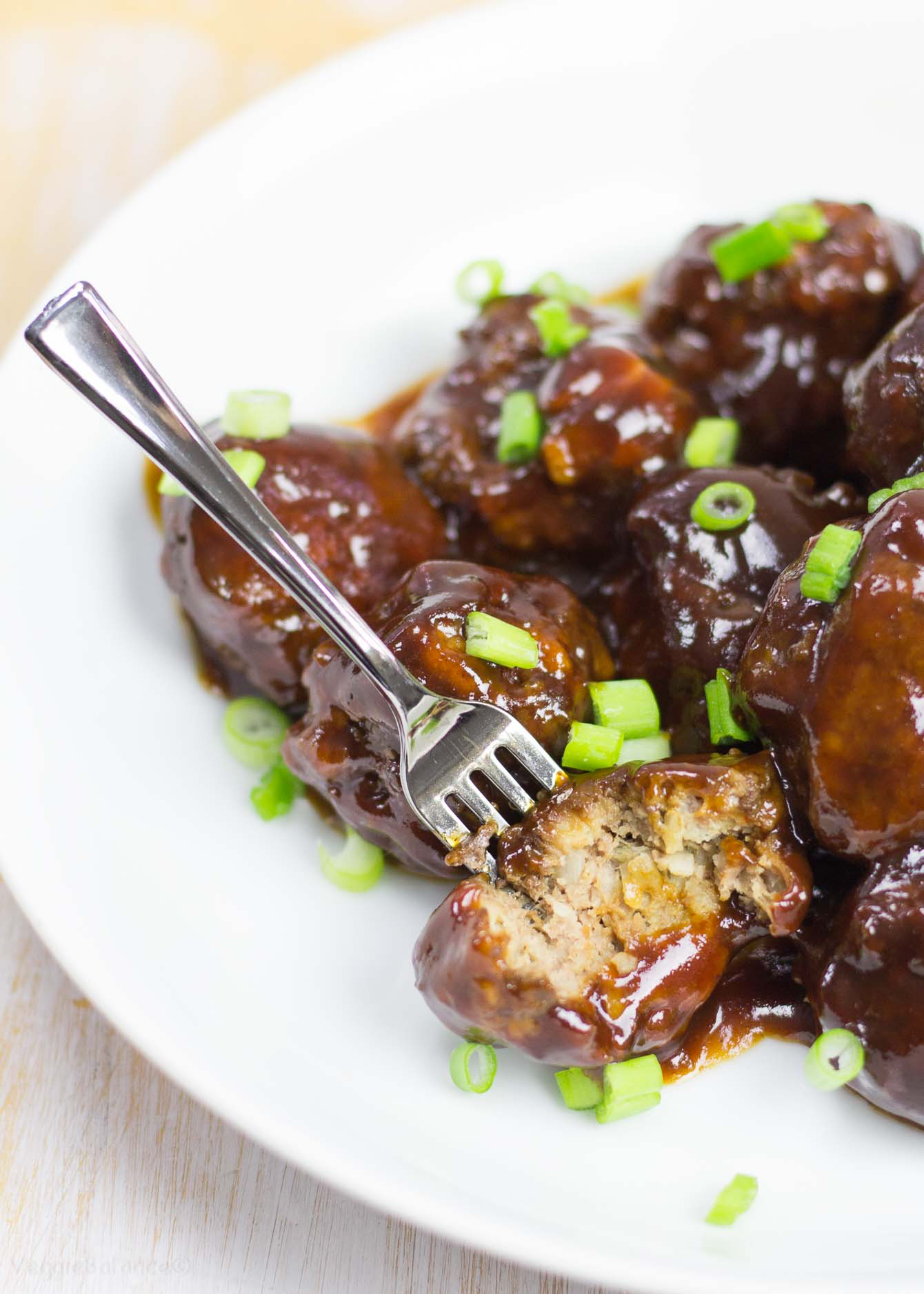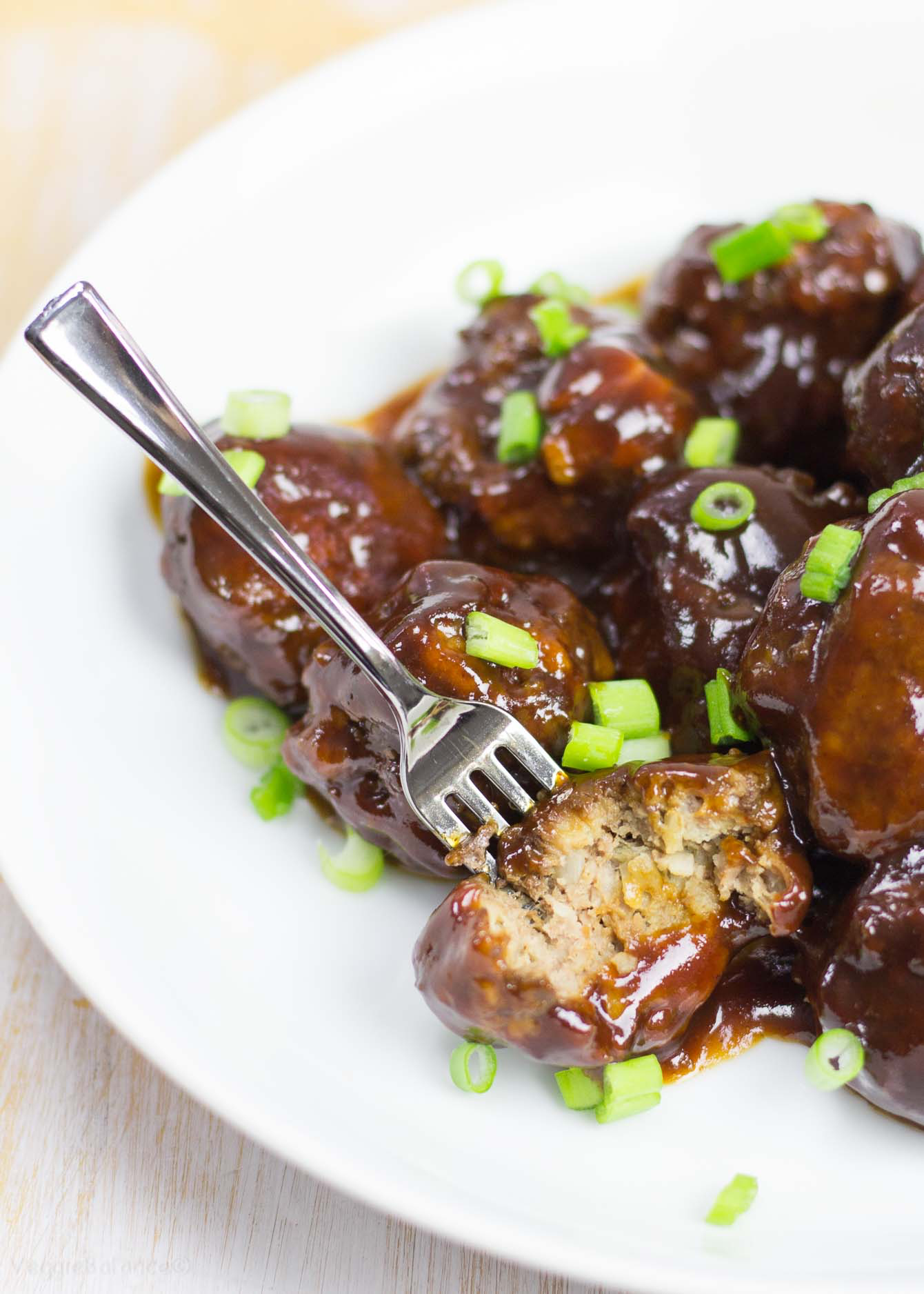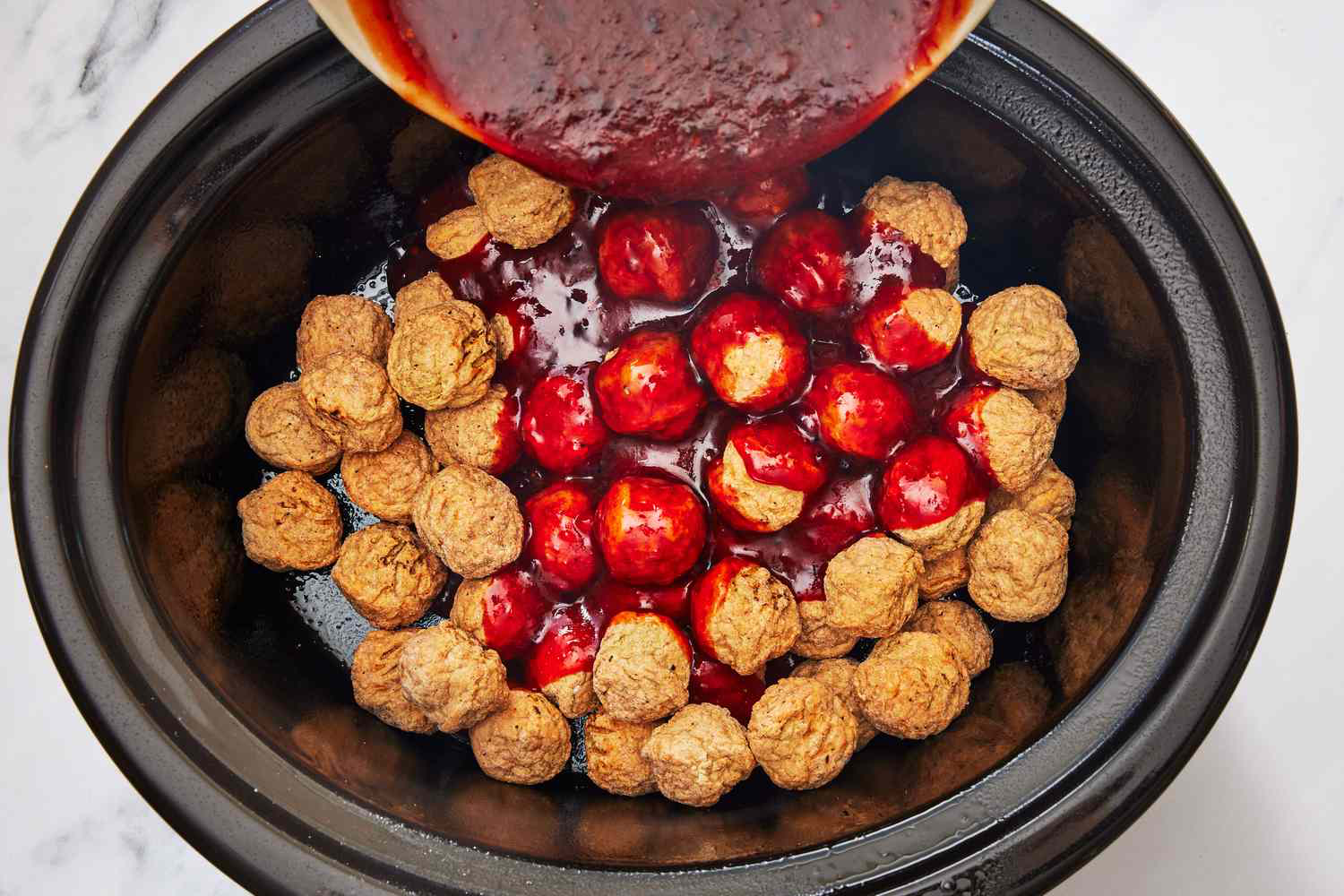Slow Cooker BBQ Meatballs: From Scratch or Frozen

Hi — I’m Chef Marcus, and this one’s all about slow cooker barbecue meatballs.
Not the ones you eat with spaghetti. Not the ones you serve with gravy. These are sticky, saucy, soft-in-the-middle meatballs that simmer for hours and end up sweet, smoky, and just enough messy. The kind you spear with a toothpick or pile onto mashed potatoes when no one’s looking.
They’re simple — but they’re also easy to mess up. Overcook them and they fall apart. Undersauce them and they dry out. Use the wrong meat or the wrong barbecue sauce, and they don’t land like they should. That’s what this guide is for.
Foreword: The First Time I Made Them
The first time I made barbecue meatballs in a slow cooker, it was for a family thing. One of those “bring something” events where half the table was already taken — the ham, the rolls, the green bean casserole with the crushed onions on top. So I showed up with a Crockpot full of frozen meatballs, a bottle of store-brand barbecue sauce, and a prayer.

It worked. Mostly. People ate them. But the sauce got too thick. The meatballs at the bottom stuck. The flavor was fine, but not good. That was the moment I realized: this dish could be better without being harder. Better meatballs. Better sauce. Better timing. Nothing fancy — just intentional.
Since then, I’ve made them from scratch, made them with frozen shortcuts, served them at parties, and even eaten them on a roll at 11 p.m. over the sink. They’ve earned their place. And if you give them just a little more care than “dump and forget,” they’ll hit every time.
Let’s walk through how to do it right — from frozen bag to full tray, from store sauce to homemade, from okay to gone by halftime.
What These Meatballs Are (and What They Aren’t)
Barbecue meatballs live in a weird little in-between space: not quite appetizer, not quite main dish. They’re party food that somehow works on a dinner plate. And more than anything, they’re comfort food disguised as finger food.

These aren’t spaghetti meatballs. They’re not glazed cocktail meatballs. And they’re definitely not trying to be smoked brisket in ball form. What makes barbecue meatballs different is the combination of sauce, slow simmer, and how they’re served — hot, sticky, and often straight out of the pot.
They’re built for gatherings. Or low-effort Sundays. Or the kind of dinner where no one’s going to complain if it comes with mac and cheese and cornbread instead of vegetables.
What makes a good one:
- Soft texture, but not mush
- Sauce that clings, not puddles
- Enough seasoning to hold up after hours of simmering
- Enough moisture and fat to survive the long cook
- No weird grit, rubbery outsides, or “mystery meat” texture
This guide is going to show you how to get all that — whether you’re using frozen meatballs from the store or rolling them yourself.
Homemade vs. Frozen — What to Know Before You Start
You can make barbecue meatballs two ways: roll them yourself, or grab a frozen bag and call it a day. Both are legit. The choice comes down to time, taste, and how much you care about the meatball itself.
Frozen Meatballs:
They’re easy, consistent, and require zero prep. You can pour them straight from the bag into the slow cooker, cover them in sauce, and walk away. The downside? You get what you get. Texture tends to be dense, and flavor is usually mild to bland. Some are seasoned, some aren’t. And they’re often pumped full of binders that make them survive processing, but not necessarily thrive after three hours in hot sauce.
Still — if you’re short on time or cooking for a crowd that’s more “eating” than “evaluating,” frozen gets the job done. Just start with a sauce that has flavor, keep the cook time tight (don’t leave them on all day), and stir gently.
Homemade Meatballs:
More work, yes. But also more control. You choose the meat, the fat content, the size, the seasoning. You get better texture — tender, juicy, and less rubbery. You can mix in onion, garlic, herbs, even cheese if you want. And you can size them to match your goal: bite-sized for parties, a little bigger if this is dinner.
But homemade meatballs come with their own risks. If they’re not mixed right or bound properly, they fall apart in the slow cooker. Especially if you throw them in raw. Undercooked centers, crumbly outsides, meatballs that break when stirred — all fixable, but worth planning for.
A few ground rules:
- If you use frozen: Don’t overcook. 2 hours on high or 3–4 on low is plenty. Stir gently, and watch your sauce — sugar-heavy barbecue sauces can scorch if you leave them too long.
- If you use homemade: Brown them first if you can. Even a quick sear helps them hold together and adds flavor. If you go in raw, make sure they’re firm, well-bound, and don’t over-stir early on.
- Either way: Use enough sauce to coat and simmer — not drown. Too much liquid waters everything down. Too little, and the sauce dries out or burns around the edges.
Next up: let’s talk about the meatball itself — what kind of meat works best, how to mix it, bind it, and season it so it holds up in the slow cooker without falling apart or drying out.
The Meatball Itself — What Works, What Doesn’t
Whether you’re making them from scratch or choosing frozen with some thought, the meatball is doing a lot of work here. It’s got to hold together, stay tender, carry seasoning, and soak up sauce — all without turning into a hockey puck or disintegrating in the pot.
The Best Meat Blends
- All-beef: Reliable, especially 80/20. Holds shape, stays moist, and doesn’t compete with barbecue flavor. Just don’t go too lean or you’ll dry them out before the sauce kicks in.
- Beef + pork: The best of both — beef for structure, pork for fat and softness. Great for homemade meatballs that simmer a long time.
- Turkey or chicken: Fine, but you have to baby them. Use dark meat if possible. Lean blends need fat added back in (oil, cheese, milk-soaked breadcrumbs). They’re more prone to drying out in the slow cooker.

Fat Content Matters
You want some fat — not just for flavor, but because lean meat tightens when it cooks. A 93/7 turkey meatball or a 90/10 beef mix is more likely to shrink, toughen, and soak up too much sauce, leaving you with dry meat in sticky syrup.
Size Matters, Too
Smaller than a golf ball = good for appetizers, faster to cook, more surface area for sauce. Bigger than that, and you risk undercooked centers or a sauce that can’t keep up.
Consistency matters more than size — don’t mix and match big and small or you’ll have dry ones and mushy ones in the same pot.
Binders: What Holds Them Together
- Breadcrumbs + egg is the classic combo. Breadcrumbs soak up moisture, egg holds the shape.
- Additions like grated onion, milk, or cheese (parmesan, cheddar) help with flavor and softness.
- If you skip the binder or try to go low-carb, expect a firmer meatball that might crack or break when stirred.
Mix gently. Overworking the meat makes it tough. Stir just until combined, then roll with wet hands and chill them for 15 minutes if you’ve got time — it helps them stay round and hold together in the cooker.
Seasoning for Barbecue
These aren’t Italian meatballs. No oregano. No basil. Think savory with a little heat:
- Garlic powder, onion powder, smoked paprika, mustard powder, chili powder, cumin, Worcestershire, black pepper.
- Salt is crucial. If the sauce is sweet (and most barbecue sauces are), you need the meat to balance it out.
Next: the sauce. Because it matters more than people think — not just which kind, but when to add it, how much to use, and what actually holds up in a slow cooker for hours without turning into burnt syrup.
The Sauce — Store-Bought, Homemade, and What Actually Tastes Good After 4 Hours on Low
The sauce makes or breaks slow cooker barbecue meatballs. But not because it’s fancy — because it’s what carries the dish after hours of low heat. If it’s too sweet, it scorches. If it’s too thin, it slides right off. And if there’s too much of it, you end up with meatballs swimming in sauce soup instead of something rich and sticky.

Here’s how to get it right.
Store-Bought Sauces
Totally fine — in fact, smart for most weeknight or potluck situations. But not all barbecue sauces are built for slow cookers. Some taste great cold but fall apart under heat — especially ones loaded with sugar or cornstarch thickeners.
Look for:
- Balanced flavor — sweet, tangy, maybe a little smoky, but not pure brown sugar.
- Thinner consistency — slow cooking will thicken it, so if it starts too gloopy, it’ll end up like glue.
- Low corn syrup content — it burns faster and sticks to the sides of the slow cooker if left too long.
Don’t use the whole bottle blindly. Start with enough to coat the meatballs. You can always add more later if it cooks down too far.
Homemade Quick Sauce
Making your own doesn’t need to be complicated. A basic barbecue-style sauce can come together in five minutes. This one’s flexible and slow-cooker friendly:
- 1 cup ketchup
- 2–3 tablespoons brown sugar
- 1 tablespoon apple cider vinegar
- 1 tablespoon Worcestershire sauce
- 1 teaspoon mustard (yellow or Dijon)
- ½ teaspoon garlic powder
- Pinch of chili powder or smoked paprika
Taste and tweak. Too sweet? More vinegar or mustard. Too thin? Simmer it for 5 minutes on the stove before it hits the pot. Want heat? Add sriracha, hot sauce, or a spoonful of chipotle in adobo.
Optional Add-Ins for Variation
- Honey or maple syrup (for sticky-sweet glaze)
- Sriracha or gochujang (for heat and depth)
- Bourbon (cook it off first or reduce it with the sauce)
- Pineapple juice (sweet and tangy — great with turkey meatballs)
- Mustard (cuts through sweetness and balances fattier meats)
When and How Much to Use
Don’t drown the meatballs. Use enough sauce to coat and give them a shallow pool to sit in. If you dump in the whole bottle right away, you’ll end up with a reduced, sugary crust around the slow cooker edges — and the meatballs won’t taste like anything except hot sauce concentrate.
Start with about 1½ to 2 cups of sauce for 2 pounds of meatballs. You can add more near the end if it’s getting too thick. And if it’s looking too loose after a few hours? Crack the lid and let it reduce for 20–30 minutes.
Next: how long to actually cook the meatballs — depending on whether they’re frozen, homemade, raw, or browned first. Because yes, cook time changes everything. Let’s break that down.
Cooking Time and Temp — Low and Slow or Fast and Hot?
Slow cookers are meant to make life easier — but they’re not set-it-and-forget-it forever. Especially when it comes to meatballs. Leave them in too long, and they dry out. Rush them on high, and the sauce scorches while the centers stay bland.

So here’s how to time it right — based on what kind of meatballs you’re using.
If You’re Using Frozen Meatballs:
These are already fully cooked — all you’re doing is heating them through and letting them absorb the sauce. You do notneed hours and hours.
- Low: 3 to 4 hours
- High: 1.5 to 2 hours
- Stir halfway through if you can, just to re-coat them in sauce.
Don’t leave them in all day or they’ll go from tender to dense to mystery-meat rubber.
If You’re Using Homemade (Raw, Unbrowned):
These need more time to cook through, but also more care to stay intact.
- Low: 4 to 6 hours
- High: 2.5 to 3.5 hours
- Avoid stirring early — wait until they’ve firmed up.
The sauce should gently bubble, not boil. If it’s simmering hard, your cooker’s running hot — switch to low.
If You’re Using Homemade (Browned First):
These are easier. The outside’s already set, so you’re just finishing the cook and letting the flavors come together.
- Low: 3 to 5 hours
- High: 2 to 3 hours
- You can stir these more confidently — they’ll hold their shape.
Browning adds flavor, but also lets you shave time off the slow cook. It’s worth doing if you’ve got the extra ten minutes.
General Rules:
- Always keep the lid on. Lifting it drops the temp and adds at least 20 minutes every time you peek. Trust the process.
- If the sauce is getting too thick after 3+ hours, crack the lid slightly or stir in a splash of water, broth, or vinegar.
- If the meatballs seem done but the sauce is watery, crack the lid and cook for 20–30 minutes to reduce and thicken.
Next up: how to keep everything from turning to mush — because even if your timing is solid, there are still a few sneaky ways to ruin the texture in the last hour. Let’s talk damage control.
How to Keep Them from Turning to Mush
The first time I made barbecue meatballs in a slow cooker from scratch, I stacked them two deep, poured in the sauce, set it to low, and walked away. I came back six hours later to what looked like a meatball casserole. Half had fused into a single mass at the bottom. The others were so soft they broke apart when I tried to stir. The sauce was thick, almost tacky, and somehow still watery underneath. I served it anyway. People ate it. Nobody asked for seconds.
That’s when I learned: yes, this is an easy dish. But it’s not immune to bad habits.
If you want meatballs that stay tender but hold their shape — even after hours in sauce — here’s what actually matters.
First: Overcooking Happens in a Slow Cooker
It’s easy to forget that “low and slow” can still go too far. Frozen meatballs that just need reheating? Two hours on high or four on low, tops. Homemade? Four to six max, depending on whether you browned them. After that, they don’t fall apart from being raw — they fall apart from being tired. They’ve soaked up too much liquid, lost their shape, and turned soft all the way through.
Second: Stirring Too Early is the Fastest Way to Break Them
This one’s personal. I used to check and stir every 30 minutes like I was making risotto. Doesn’t help. All you do is poke holes in the ones that aren’t ready. If your meatballs are raw or homemade, let them firm up before touching them. An hour minimum. Two is safer. Use a spoon, not a spatula. Slide under and lift. No mashing.
Third: Sauce Consistency is Everything
Too thick, and it turns into paste before the meatballs are done. Too thin, and it never sticks — it just runs off and stews the meatballs into mush. What you want is sauce that coats a spoon but still moves. If it tightens up too much, add broth or water. If it’s loose, crack the lid for the last 30 minutes and let the cooker do its thing.
Fourth: Don’t Stack Like You’re Building a Wall
I made that mistake once for a holiday party. Two layers of meatballs, all the sauce on top. The ones on the bottom ended up flat. If you’re making a big batch, use a big pot. Stagger them if you have to stack — like bricks, not cannonballs.
And Finally: “Warm” Isn’t Harmless
Leaving them on warm for five hours after they’re done is just cooking in disguise. If you’re done, pull the plug. Or transfer to a container and reheat when it’s time to eat. Holding them in the slow cooker all day isn’t the move. Trust me — I’ve served that batch too. People ate it, sure. But no one asked what was in the sauce.
What to Serve With Barbecue Meatballs
The first time I brought barbecue meatballs to a party, I showed up with the slow cooker, the extension cord, and about forty meatballs swimming in sauce. Everyone else brought things with crunch: chips, coleslaw, crackers, trays of raw vegetables nobody touched. My meatballs went fast. But about halfway through the night, people started wandering back, asking, “Wait… what were those with? Was there bread? Spoons?”

I hadn’t brought either.
They were delicious. But they didn’t make a meal — they were just hot and convenient and messy.
Since then, I’ve thought about what barbecue meatballs actually want to be served with — whether you’re feeding a crowd, plating a dinner, or just putting out a pot and letting people fend for themselves.
If You’re Serving Them as an Appetizer:
- Toothpicks are fine, but don’t assume everyone’s coordinated. Set out small plates or napkins too.
- Keep them warm in the slow cooker on low, but stir occasionally so nothing crusts up.
- Add a small bowl of extra sauce on the side — it’s not necessary, but people will use it.
- Offer bread or rolls nearby. Trust me: people will start making mini sandwiches by hour two.
If You’re Making a Full Dinner:
- Mashed potatoes are the move. They catch the sauce, hold the heat, and round out the plate.
- Mac and cheese turns it into comfort food central.
- Cornbread, if you want something firm and a little sweet. Bonus points if it’s grilled or toasted.
- Add green beans, roasted broccoli, or a simple slaw to cut the richness — not because it’s required, but because it balances the plate.
If You’re Going Party-Style:
- Put the meatballs in one slow cooker.
- Put Hawaiian rolls or slider buns next to them.
- Add sliced pickles, coleslaw, or even shredded cheese to a small toppings bar.
- Now you’ve got build-your-own barbecue sliders, and you didn’t even turn on the oven.
And if it’s just you, reheating a few on the stove and eating them over the sink?
Respect.
Wrap them in a tortilla.
Pile them on toast.
Eat them cold.
I’ve done all of it, and if the sauce was right, they were still good.
Variations That Actually Work
Over the years, I’ve seen (and made) a lot of barbecue meatball experiments — some brilliant, some… better on paper. It’s easy to throw a new flavor into the sauce and hope for the best. But not everything holds up in a hot pot for five hours. These ones do.
Cranberry BBQ Meatballs
The holiday classic.
Take your basic barbecue sauce and stir in a can of whole berry cranberry sauce. That’s it. The tang from the cranberries cuts through the sweetness, and the texture blends down into something rich but still sharp. Works especially well with turkey meatballs — it leans Thanksgiving, but in a good way.
Ratio:
1 cup barbecue sauce + 1 can whole cranberry sauce + splash of orange juice or vinegar to balance.
Gochujang or Chipotle BBQ
For when sweet isn’t cutting it.
Mix spicy Korean gochujang or smoky chipotle in adobo into your base sauce. Not too much — both pack heat and salt — but just enough to give the whole dish a backbone. Suddenly your meatballs have real depth.
Pro move: Add a splash of soy sauce and a pinch of brown sugar to round it out.
Honey Garlic BBQ
A little sweeter, a little stickier.
This one’s great for serving over rice or making lettuce wraps. Add minced garlic (or garlic powder if you’re shortcutting) and a couple tablespoons of honey to your sauce. Let it simmer down until it’s glossy and clingy.
Pairs well with chicken or pork meatballs. Not ideal with super-sweet store sauces — make your own base or cut with vinegar.
Peach or Pineapple BBQ
Summer cookout vibes.
Add peach preserves or crushed pineapple (drained well) to your barbecue sauce. You’ll get a juicy, fruity glaze that sticks like lacquer and tastes like backyard grill season. Add chili flakes or hot sauce to keep it from going full dessert.
Goes best with pork or beef meatballs. Bonus if you finish with lime or fresh herbs right before serving.
Bourbon BBQ
For when it’s late and you’re feeding adults.
Simmer down a splash of bourbon (2–3 tablespoons) with your sauce until the alcohol cooks off. It deepens the flavor and adds a kind of warmth you can’t quite name but definitely notice. Great with a little molasses or dark brown sugar.
Don’t overdo it. This isn’t a cocktail. It’s a meatball with better posture.
Each of these holds up to slow heat, clings to the meatballs, and still tastes good after four hours in a crockpot. No separation, no burned sugar, no guessing.
Next: what to do with leftovers, how to store them without losing the sauce, and how to reheat them so they taste like something you want to eat again — not just something you have to finish. Let’s finish strong.
FAQ — Slow Cooker Barbecue Meatballs, Real Questions
Most of the questions about barbecue meatballs come up right when it’s already too late — the sauce is boiling, the meatballs are stuck, the texture’s off and you’re standing there wondering if it’s salvageable. This is the part you read before (or during) that moment, so you don’t have to guess.
Can I put frozen meatballs straight into the slow cooker?
Yes — absolutely. Just make sure your sauce is loose enough to coat them and you’re not stacking them three layers deep. 3–4 hours on low, max. Stir gently once they’ve warmed through.
Do I have to brown homemade meatballs first?
No. But if you don’t, make sure they’re well-bound (egg, breadcrumbs, not too wet) and let them cook on low, untouched, for at least an hour before you stir. Browning adds flavor and helps them hold together — so do it if you have time.
Why did my sauce burn or turn into paste?
Probably cooked too long or used a sauce that was too thick to start with. Keep the lid on, don’t go past 4 hours on high, and always start with a sauce that pours easily. Thin it out if needed.
Can I leave them on warm all day?
Not a great idea. “Warm” is still hot enough to overcook if left for more than 1–2 hours. If you need to hold them, switch to low and stir every 30–40 minutes. Better yet, transfer to another container and reheat when ready to serve.
Can I use turkey or plant-based meatballs?
Yes — just make sure you use enough fat or moisture in the mix. Turkey works best with dark meat or added oil. Plant-based meatballs should be fully cooked before going in, and they don’t need long in the sauce — 1–2 hours on low, tops.
Can I double the batch?
Yes, but use a large slow cooker and stir once or twice during cooking to keep things even. You may need to add a bit more sauce and go a little longer — especially if you’re starting from frozen.
How do I keep them from sticking to the bottom?
Add enough sauce to coat the bottom, and don’t crank the heat. Keep the cooker on low and stir once gently midway through the cook. If your sauce has a lot of sugar, it’s more likely to scorch — thin it slightly to start.
Barbecue meatballs aren’t complicated. But like anything simple, they can turn on you fast if you don’t respect the timing, texture, or heat. Get those right — and stop treating the slow cooker like a magic box — and they’ll come out better every time. Whether you made them from scratch or cracked open a frozen bag, the outcome’s in the details.
Let’s close it out — calmly, without hype, just the kind of wrap-up that leaves you feeling like you know exactly what you’re doing the next time someone says, “Hey, could you bring meatballs?”
Closing: It’s a Slow Cooker Full of Meatballs — Let’s Not Overcomplicate It
At the end of the day, barbecue meatballs aren’t a flex. They’re not supposed to be a culinary masterpiece. They’re supposed to show up hot, coated in sauce, and disappear one by one until somebody’s scraping the bottom of the pot with a spoon and wondering if there’s more in the kitchen.
But just because they’re simple doesn’t mean you have to make them sloppy. A little attention to the meat, the sauce, the timing — that’s all it takes to make sure they hit right every time. Whether you’re making them from scratch, pouring them in from a bag, or reheating leftovers over mashed potatoes at 10 p.m., the goal is the same: soft, saucy, gone before you expected it.
So keep the slow cooker out. Trust your timing. Stir less. Taste more. And don’t be surprised if you don’t bring any home.